Among the many treasures preserved in the Sir Mangaldas Nathubhai family collection is a slim, timeworn album belonging to his great-granddaughter Meenal. Its pages, still intact after a century, neatly inscribed with signatures and photographs, carry the imprints of cricketing legends from the early decades of the twentieth century.
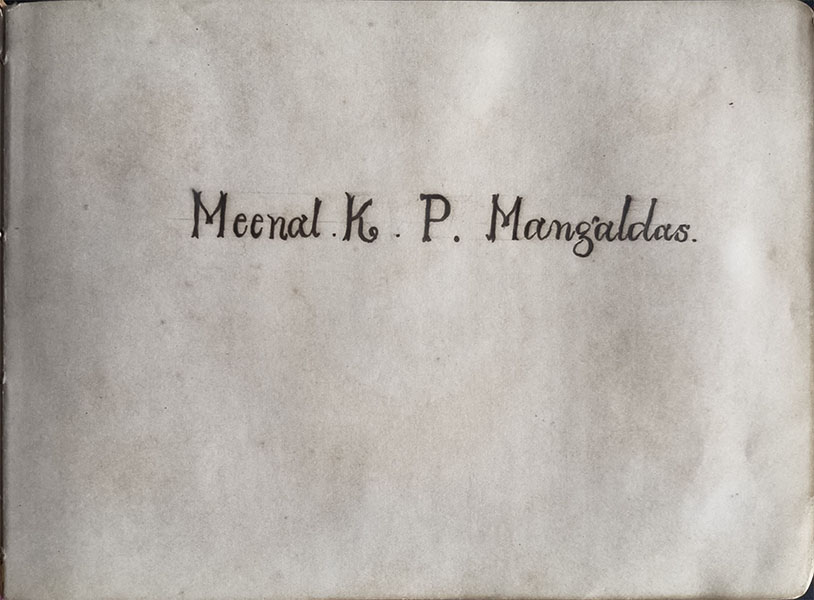
Ownership inscription of Meenal K.P. Mangaldas, great-granddaughter of Sir Mangaldas Nathubhai
More than a keepsake, this autograph book is a window into a formative period in the sport’s history, when cricket, “the gentlemen’s game”, was still finding its voice in colonial India and when international tours brought together princely patrons, Indian trailblazers, and visiting Australian and English sides.
That this precise volume sits within the broader Mangaldas collection, renowned for its breadth, from art to decorative objects, is no coincidence. It reflects the same instinct to safeguard fragments of cultural history, carefully preserving and carrying them forward.
Here, those fragments take the form of inked names and grainy photographs, each once celebrated on cricket fields around the world.
Signatures of a Golden Age
The autograph book features an eclectic roster of players and other public figures. Some were household names in their time, others cult figures, and a few went on to shape Indian cricket for decades. Highlighting just a selection, perhaps the most prominent, captures the spirit of this rare compilation preserved by the Mangaldas family.
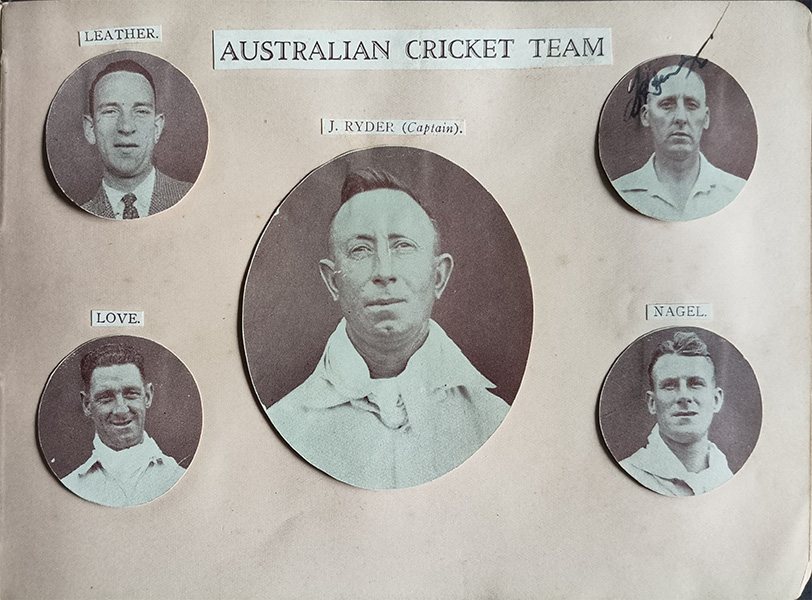
Jack Ryder, captain of the Australian touring side shown here with teammates Leather, Love, and Nagel in the Mangaldas family autograph book.
Jack Ryder – Captain of the Australian touring side in the 1920s, Ryder was a rugged middle-order batsman and a capable leader. Known for his resilience after the First World War, he symbolised Australia’s fighting spirit in an era of rebuilding.
Charlie Macartney – Nicknamed the “Governor-General,” Macartney was among the most stylish Australian batsmen of his generation. His daring strokeplay, especially against England, helped redefine batting flair at a time when cricket was often considered conservative.
Bert Ironmonger – A remarkable story in his own right, Ironmonger debuted for Australia in his mid-forties. A left-arm spinner with guile rather than pace, he became a cult hero and remains the oldest man to have played Test cricket for his country.
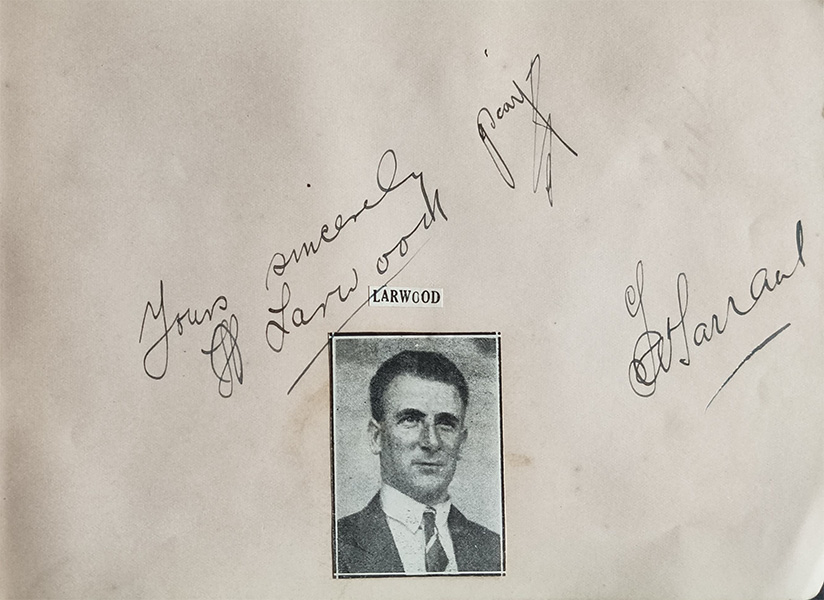
Harold Larwood of the England cricket team, autograph taken during the 1933–34 India tour — remembered for his fearsome pace and role in the Bodyline series
Harold Larwood – Though remembered most for the controversial Bodyline series against Australia in 1932–33, Larwood was already a formidable fast bowler when his autograph was captured. His presence in the book reflects the global aura surrounding pace bowlers at a time when speed was as feared as it was admired.
The Nawab of Pataudi (Sr.) – The first Indian to play Test cricket for England, Iftikhar Ali Khan Pataudi embodied the nexus of cricket, empire, and royalty. His career straddled two worlds, a princely upbringing in India and the prestige of representing England at Lord’s.
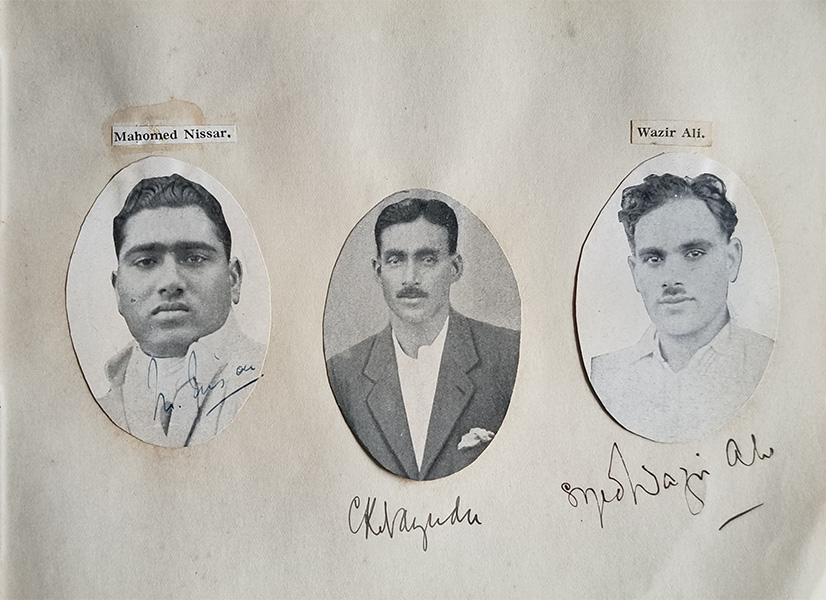
Autograph page from the Mangaldas family collection, Mohammad Nissar, C.K. Nayudu, and Wazir Ali — pioneers of Indian Test cricket.
Mohammad Nissar – Revered as India’s first great fast bowler, Nissar’s raw pace shocked England in India’s debut Test at Lord’s in 1932. To hold his autograph is to have a piece of that moment when India announced its arrival on the international stage.
Mushtaq Ali – A crowd favourite, Mushtaq was the first Indian batsman to score a Test century overseas, at Old Trafford in 1936. His flamboyant strokeplay and partnerships with Vijay Merchant captivated audiences and gave Indian cricket its first true batting stars.
Lala Amarnath – Another pioneer, Amarnath was the first Indian to score a Test century on home soil. Revered for his competitive spirit and leadership skills, his signature in the book speaks to his role as both player and symbol of a new cricketing confidence.
Vijay Merchant – A batsman of rare technical mastery, Merchant’s feats in domestic cricket are legendary to this day. His name evokes an era when Indian batting excellence was beginning to rival that of established cricketing nations.
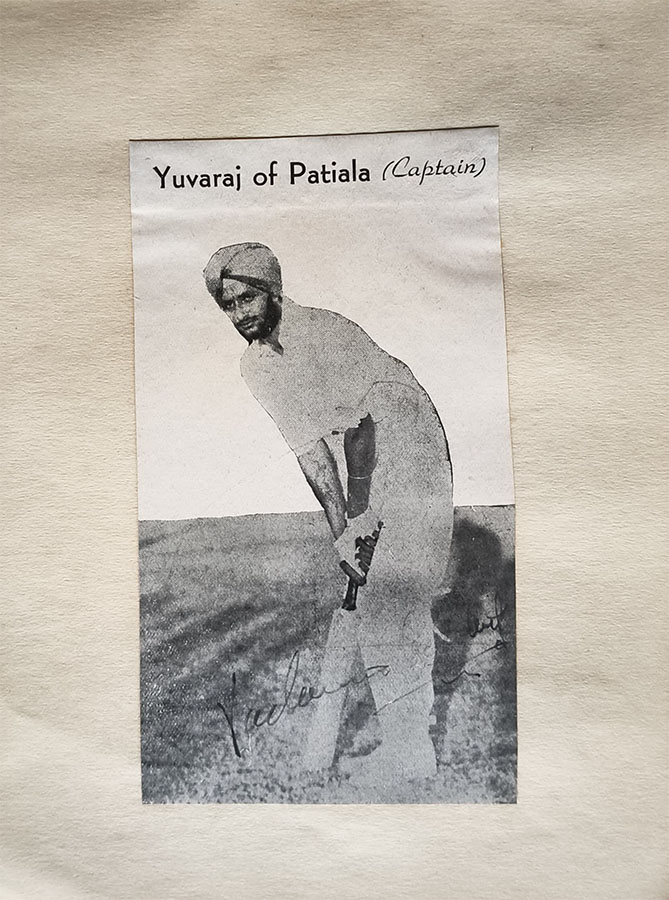
The Yuvraj of Patiala, whose royal patronage sustained Indian cricket, autograph page from the Mangaldas family collection
The Yuvraj of Patiala – More than a player, the prince represented the long tradition of royal patronage in Indian cricket. Figures like him ensured the sport’s infrastructure thrived, financing clubs, tournaments, and tours that laid the groundwork for future generations.
Vinoo Mankad – One of India’s greatest all-rounders, Mankad played in the 1940s–1950s and was known for his exceptional left-arm spin and dependable batting. He made history by being part of the first generation of Indian cricketers to gain international recognition. His signature in the collection adds both historical and cricketing gravitas.
K. Nayudu – India’s first Test captain and a towering figure in Indian cricket, Nayudu’s influence extended beyond the pitch, symbolising India’s emergence on the international cricket stage. His autograph would have been highly prized in the pre-independence period.
Grouped alongside the aforementioned players are other Bombay stalwarts: D.B. Deodhar, often called the “Grand Old Man of Indian Cricket”; J.G. Navle, India’s first Test wicket-keeper; L.P. Jai and R.J.D. Jamshedji, who were part of India’s earliest Test squads, and D.D. Hindlekar, who kept wicket with reliability. Together, they reflect the deep reservoir of cricketing talent emerging from Indian cities in the pre-independence years.
Cricket and Empire: A Colonial Stage
More than a collection of names, signatures, and photographs, this priceless book from the Mangaldas collection embodies cricket’s role as both cultural bridge and contested ground during the colonial rule.
The presence of Australian internationals, English professionals, Indian royals, and local Bombay cricketers on its pages illustrates how the sport blurred hierarchies even as it operated within them.
For Indian fans and patrons, collecting such signatures was not merely about admiration; it was an act of participation in a global sporting culture. Cricket, imported as an imperial pastime, was being claimed and redefined by Indians as their own.
Autograph books like this one served as symbols of connection, between colony and empire, between fans and their heroes, between fleeting moments on the field and enduring memory on the page.
A Collector’s Eye, A Family’s Legacy
Beyond his contributions to public welfare, Mangaldas was committed to preserving and promoting cultural heritage. His Girgaum bungalow, constructed in 1855, became a hub for social gatherings and intellectual discourse, hosting notable figures of the time, including the Duke and Duchess of Connaught. This environment of learning and exchange fostered a deep appreciation for art, literature, and sport within the family.
The presence of the Cricket Autograph Book within the Nathubhai collection reflects this cultural ethos. It serves as a curated fragment of history, capturing an era when cricket was emerging as a significant sport in India. The book not only showcases the signatures of renowned cricketers but also symbolises the family's commitment to preserving moments that encapsulate the spirit of the times.
In the end, the Cricket Autograph Book speaks to two legacies. The first is cricket’s, a sport that, by the 1930s, had become both a unifying passion and a stage for India’s assertion of sporting identity. The second is the Mangaldas family’s, their instinct to collect, to preserve, and to pass on objects that hold meaning far beyond their material form.
What remains today is not simply a book of signatures, but a curated fragment of history: a record of an age when cricket in India was young, and when a family of collectors understood that even ink on paper could capture the echoes of the pitch.